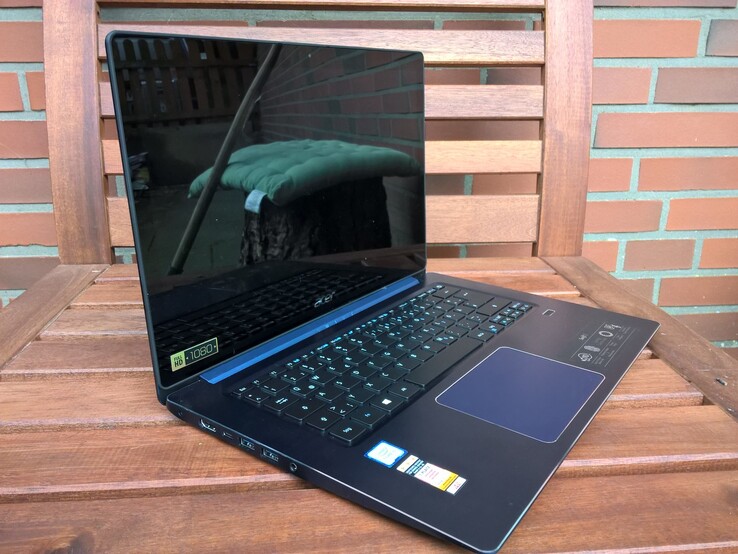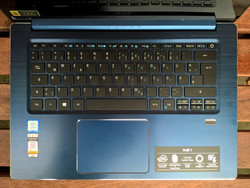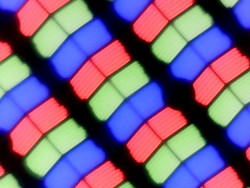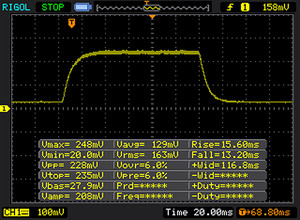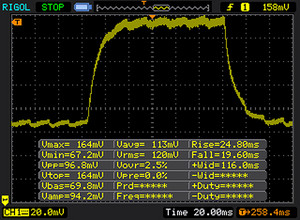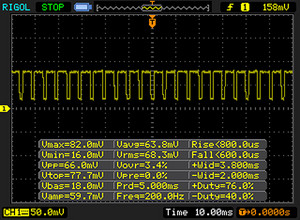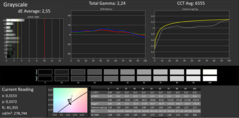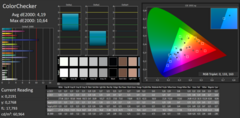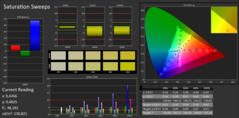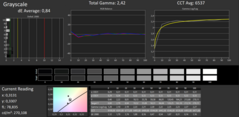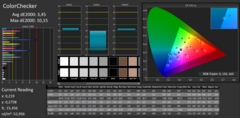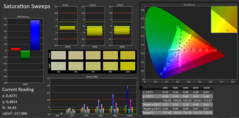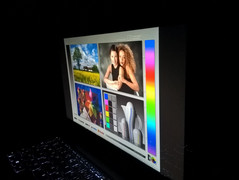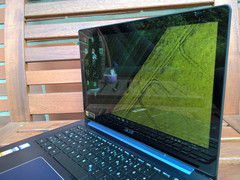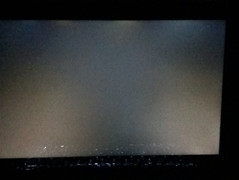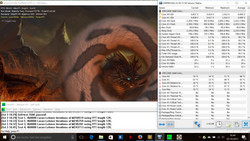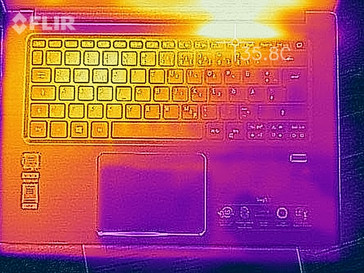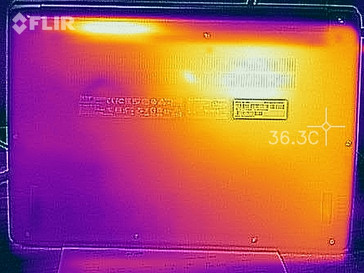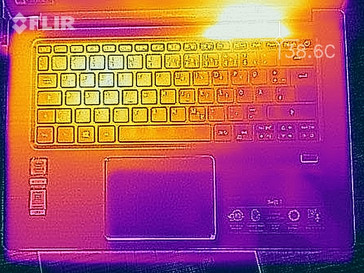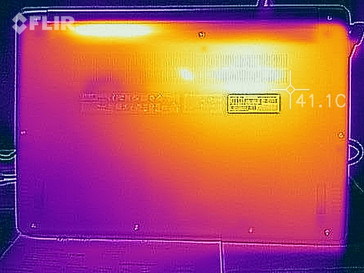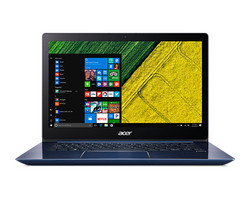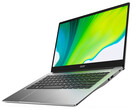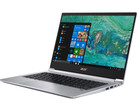Acer Swift 3 (i5-7200U, HD 620) Laptop Review

For the original German review, see here.
Acer offers various laptop models with a similar configuration. Every laptop series is aimed at different target groups. The devices in the Swift lineup have been conceived for design-oriented buyers and are available in different hardware configurations. Our review sample is an Acer Swift 3 with an Intel Core i5-7200U CPU, an integrated Intel HD Graphics 620 graphics card, a 256 GB SSD, and 8 GB of working memory. The configuration points to a laptop that is suitable for office tasks and basic multimedia applications.
The competitors that we have selected feature a similar configuration and are positioned in the same price range. The Swift 3 faces the Aspire 3 also by Acer, HP's EliteBook 840 G4, and Fujitsu's LifeBook U747. We have also added Lenovo's ThinkPad X1 Carbon 2017 as a more expensive member of this laptop category for comparison.
Case and Connectivity
Acer delivers our review sample in the color "Stellar Blue". This, in conjunction with the casing made of brushed aluminum, gives the Swift 3 a very high-quality look. The area below the keyboard is plastic, but it does not look that different from the rest of the casing. There are no maintenance hatches on the underside. We tried to remove the base tray, but we had the feeling that we would either damage or warp the casing if we persisted.
The hinges keep the display firmly in the set position. It does not rock when the laptop is moved. Since the lid of the Swift 3 is also made of brushed aluminum, the display is correspondingly resistant. Its glossy glass surface gives it additional protection.
Connectivity
Acer has placed all interfaces in the rear area of the Swift 3's sides. Consequently, they do not interfere when using a mouse. We particularly like the modern selection of interfaces. Two USB 3.0 ports and a USB Type-C port have not been part of the basic configuration of Acer's cheaper models until now. The other interfaces cover the requirements of most everyday peripherals that are connected to a laptop.
| SD Card Reader | |
| average JPG Copy Test (av. of 3 runs) | |
| HP EliteBook 840 G4-Z2V49ET ABD | |
| Fujitsu LifeBook U747 | |
| Lenovo ThinkPad X1 Carbon 2017-20HR0021GE | |
| Acer TravelMate X349-G2 | |
| Acer Swift 3 (i5-7200U, HD 620) | |
| maximum AS SSD Seq Read Test (1GB) | |
| Lenovo ThinkPad X1 Carbon 2017-20HR0021GE | |
| HP EliteBook 840 G4-Z2V49ET ABD | |
| Fujitsu LifeBook U747 | |
| Acer Swift 3 (i5-7200U, HD 620) | |
| Acer TravelMate X349-G2 | |
Input Devices
The keys in the Swift 3's chiclet keyboard have a very sleek surface. However, the fingers do not slip off the surface, but astonishingly manage to hit the exact center. The smooth typing feel sometimes tends to get spongy. After working a while with the keyboard, we got used to it and could type fast and without typos. The arrow and scroll keys are very small and the positioning of the delete key directly beside the power button is quite inconvenient.
The keys' sleek surface is also found in the ClickPad. Thus, even lightly moist fingers glide pleasingly fast over the mouse replacement. The keys can be triggered anywhere on the pad. Mouse movement was sometimes not detected when "pressing" the key in the test. Thus, drag and drop did not function reliably.
Display
A clear image characterizes the Full HD panel with a resolution of 1920x1080 pixels in the Swift 3. The average brightness of 259 cd/m² is slightly lower than that of the comparison devices. We determined PWM in our measurements. The screen flickers at 200 Hz in a brightness level of 20%. Users with sensitive eyes might find this unpleasant.
| |||||||||||||||||||||||||
Brightness Distribution: 81 %
Center on Battery: 281 cd/m²
Contrast: 624:1 (Black: 0.45 cd/m²)
ΔE ColorChecker Calman: 4.19 | ∀{0.5-29.43 Ø4.77}
ΔE Greyscale Calman: 2.55 | ∀{0.09-98 Ø5}
61% sRGB (Argyll 1.6.3 3D)
39% AdobeRGB 1998 (Argyll 1.6.3 3D)
42.34% AdobeRGB 1998 (Argyll 3D)
61.4% sRGB (Argyll 3D)
40.96% Display P3 (Argyll 3D)
Gamma: 2.24
CCT: 6555 K
| Acer Swift 3 (i5-7200U, HD 620) Chi Mei CMN14C9, , 1920x1080, 14" | HP EliteBook 840 G4-Z2V49ET ABD AUO123D, , 1920x1080, 14" | Acer TravelMate X349-G2 ChiMei CN14C9, , 1920x1080, 14" | Fujitsu LifeBook U747 LG LP140WF3, , 1920x1080, 14" | Lenovo ThinkPad X1 Carbon 2017-20HR0021GE B140HAN03_1, , 1920x1080, 14" | |
|---|---|---|---|---|---|
| Display | 34% | 2% | 48% | 47% | |
| Display P3 Coverage (%) | 40.96 | 55.8 36% | 41.81 2% | 66.1 61% | 61.6 50% |
| sRGB Coverage (%) | 61.4 | 80.7 31% | 62.3 1% | 84.8 38% | 87.6 43% |
| AdobeRGB 1998 Coverage (%) | 42.34 | 57.7 36% | 43.26 2% | 62 46% | 62.6 48% |
| Response Times | 14% | -7% | 17% | -11% | |
| Response Time Grey 50% / Grey 80% * (ms) | 43 ? | 39 ? 9% | 43 ? -0% | 36 ? 16% | 48 ? -12% |
| Response Time Black / White * (ms) | 28 ? | 23 ? 18% | 32 ? -14% | 23.2 ? 17% | 30.4 ? -9% |
| PWM Frequency (Hz) | 200 ? | 25000 ? | |||
| Screen | -49% | -9% | 14% | 34% | |
| Brightness middle (cd/m²) | 281 | 346 23% | 271 -4% | 291 4% | 278 -1% |
| Brightness (cd/m²) | 259 | 317 22% | 253 -2% | 296 14% | 271 5% |
| Brightness Distribution (%) | 81 | 86 6% | 83 2% | 84 4% | 91 12% |
| Black Level * (cd/m²) | 0.45 | 0.86 -91% | 0.35 22% | 0.32 29% | 0.16 64% |
| Contrast (:1) | 624 | 402 -36% | 774 24% | 909 46% | 1738 179% |
| Colorchecker dE 2000 * | 4.19 | 8.64 -106% | 5.05 -21% | 4.3 -3% | 4.5 -7% |
| Colorchecker dE 2000 max. * | 10.64 | 13.58 -28% | 11.74 -10% | 7.5 30% | 8.4 21% |
| Greyscale dE 2000 * | 2.55 | 11.24 -341% | 4.3 -69% | 4.3 -69% | 3.2 -25% |
| Gamma | 2.24 98% | 2.62 84% | 2.44 90% | 2.31 95% | 2.02 109% |
| CCT | 6555 99% | 12530 52% | 6726 97% | 6529 100% | 7042 92% |
| Color Space (Percent of AdobeRGB 1998) (%) | 39 | 52 33% | 42 8% | 55.46 42% | 57 46% |
| Color Space (Percent of sRGB) (%) | 61 | 80 31% | 39 -36% | 84.77 39% | 87.5 43% |
| Total Average (Program / Settings) | -0% /
-24% | -5% /
-6% | 26% /
21% | 23% /
30% |
* ... smaller is better
Display Response Times
| ↔ Response Time Black to White | ||
|---|---|---|
| 28 ms ... rise ↗ and fall ↘ combined | ↗ 15 ms rise | |
| ↘ 13 ms fall | ||
| The screen shows relatively slow response rates in our tests and may be too slow for gamers. In comparison, all tested devices range from 0.1 (minimum) to 240 (maximum) ms. » 70 % of all devices are better. This means that the measured response time is worse than the average of all tested devices (20.2 ms). | ||
| ↔ Response Time 50% Grey to 80% Grey | ||
| 43 ms ... rise ↗ and fall ↘ combined | ↗ 24 ms rise | |
| ↘ 19 ms fall | ||
| The screen shows slow response rates in our tests and will be unsatisfactory for gamers. In comparison, all tested devices range from 0.165 (minimum) to 636 (maximum) ms. » 70 % of all devices are better. This means that the measured response time is worse than the average of all tested devices (31.6 ms). | ||
Screen Flickering / PWM (Pulse-Width Modulation)
| Screen flickering / PWM detected | 200 Hz | ≤ 20 % brightness setting | |
The display backlight flickers at 200 Hz (worst case, e.g., utilizing PWM) Flickering detected at a brightness setting of 20 % and below. There should be no flickering or PWM above this brightness setting. The frequency of 200 Hz is relatively low, so sensitive users will likely notice flickering and experience eyestrain at the stated brightness setting and below. In comparison: 53 % of all tested devices do not use PWM to dim the display. If PWM was detected, an average of 8084 (minimum: 5 - maximum: 343500) Hz was measured. | |||
The Swift 3's color space coverage of 61% in sRGB and 39% in AdobeRGB has to be described as mediocre. Subjectively, the colors are pleasing, but are also covered by a slight grayish haze. The somewhat high black value explains this impression.
Working in lighted rooms is no problem with our review sample. However, the disadvantages of a glossy screen become evident outdoors. The brightness would be sufficient for working under cloudy skies on the patio. However, the intensity of the reflections makes this impossible.
On the other hand, the viewing angle stability is superb. The content is quite legible from all angles. A black screen displays visible backlight bleeding.
Performance
The Swift 3's performance is sufficient for most office tasks and basic multimedia applications. Our review sample is equipped with an i5-7200U CPU from Intel. Acer also offers the Swift 3 with a variety of i3, i5, and i7 Intel CPUs. There are also many options for the working memory and storage device. With 8 GB of RAM, our model is suitably equipped for most tasks. The integrated HD Graphics 620 graphics solution from Intel is not suitable for demanding graphics applications. However, it is quite adequate for everyday use and simple games.
Processor
With the Core i5-7200U CPU, Intel delivers a fast and power efficient processor based on the Kaby Lake architecture. It supports decoding H.265/HEVC videos in the Main10 profile with a color bit depth of 10 bits and Google's VP 9 codec in the hardware. More information about Intel's Core i5-7200U can be found on our benchmark page.
The Swift 3 proved to be a bit inconsistent in the Cinebench R15 permanent test. Although it provides stable performance, the curve shows small, recurrent drops. This could be due to running background processes or an unstable cooling. For example, we noticed that the device heated up noticeably even without load in our test routine. The Cinebench benchmark scores position the Swift 3 in the midfield of the comparison devices. Since all comparison models have the same CPU, they only deviate slightly.
System Performance
As expected, the Swift 3 also positions itself in the midfield of the comparison devices in PCMark 8. The available performance is sufficient for most office tasks and basic multimedia applications. This includes simple image editing programs. Enough performance is provided also for playing music and videos.
| PCMark 8 - Home Score Accelerated v2 | |
| Lenovo ThinkPad X1 Carbon 2017-20HR0021GE | |
| Acer TravelMate X349-G2 | |
| Acer Swift 3 (i5-7200U, HD 620) | |
| Fujitsu LifeBook U747 | |
| HP EliteBook 840 G4-Z2V49ET ABD | |
| PCMark 8 Home Score Accelerated v2 | 3636 points | |
Help | ||
Storage Device
Acer has equipped the Swift 3 with a 256 GB SSD. The user has approximately 170 GB for personal use. Again, the Swift 3 delivers a midfield performance among the comparison devices. Nevertheless, the performance is decent. Our benchmark page reveals how the installed SSD scores compared to other storage devices.
| Acer Swift 3 (i5-7200U, HD 620) Intel SSD 600p SSDPEKKW256G7 | HP EliteBook 840 G4-Z2V49ET ABD Samsung PM961 MZVLW256HEHP | Acer TravelMate X349-G2 Intel SSD 600p SSDPEKKW512G7 | Fujitsu LifeBook U747 Samsung MZYTY256HDHP | Lenovo ThinkPad X1 Carbon 2017-20HR0021GE Toshiba THNSF5256GPUK | |
|---|---|---|---|---|---|
| CrystalDiskMark 3.0 | 63% | 19% | -18% | 11% | |
| Write 4k QD32 (MB/s) | 251 | 410.2 63% | 210.8 -16% | 249.7 -1% | 241.2 -4% |
| Read 4k QD32 (MB/s) | 290.1 | 513 77% | 373.7 29% | 399.1 38% | 477.3 65% |
| Write 4k (MB/s) | 108.3 | 157.1 45% | 133.4 23% | 87.8 -19% | 128.5 19% |
| Read 4k (MB/s) | 31.6 | 61.4 94% | 34.93 11% | 35.73 13% | 34.63 10% |
| Write 512 (MB/s) | 564 | 804 43% | 586 4% | 283.4 -50% | 311 -45% |
| Read 512 (MB/s) | 800 | 922 15% | 1134 42% | 396.7 -50% | 972 22% |
| Write Seq (MB/s) | 606 | 1263 108% | 582 -4% | 497.8 -18% | 648 7% |
| Read Seq (MB/s) | 1137 | 1819 60% | 1818 60% | 504 -56% | 1277 12% |
Graphics Card
The installed Intel HD Graphics 620 graphics solution is suitable for most graphically undemanding applications. Since the graphics card greatly benefits from the installed working memory, the test result benefits from the Swift 3's dual-channel RAM. The Swift 3 positions itself in the second place compared with the competing devices in the 3DMark 11 performance test. Our benchmark page shows how the integrated HD Graphics 620 from Intel scores compared with other graphics solutions.
| 3DMark 11 - 1280x720 Performance GPU | |
| Lenovo ThinkPad X1 Carbon 2017-20HR0021GE | |
| Acer Swift 3 (i5-7200U, HD 620) | |
| HP EliteBook 840 G4-Z2V49ET ABD | |
| Fujitsu LifeBook U747 | |
| 3DMark 11 Performance | 1662 points | |
Help | ||
Gaming Performance
We could compare Intel's integrated HD Graphics 620 graphics solution with a dedicated Nvidia GeForce 920M in our benchmark test. Thanks to the Swift 3's dual-channel RAM, the review sample confirms this comparison.
Games the same age as “BioShock Infinite” run smoothly in medium settings and can be played well. More gaming benchmark outcomes of the HD Graphics 620 can be found on our benchmark page.
| low | med. | high | ultra | |
|---|---|---|---|---|
| BioShock Infinite (2013) | 48.61 | 30.87 | 25.2 | 7.83 |
Emissions and Energy Management
As our noise measurement shows, the Swift 3 barely produces any audible noises. The fan noise is hardly perceptible even in very quiet environments and only a quiet hum is audible during load. Thus, our review sample is perfectly suitable for quiet surroundings.
Noise level
| Idle |
| 30.6 / 30.6 / 31.1 dB(A) |
| Load |
| 34 / 31.45 dB(A) |
 | ||
30 dB silent 40 dB(A) audible 50 dB(A) loud |
||
min: | ||
Temperature
Acer's Swift 3 only achieves moderate temperature ranges. 40 °C (~104 °F) is exceeded just slightly, even during load. Our review sample heated up noticeably, particularly in the underside's left area. However, this was not to such an extent that it could no longer be used on the lap.
The core temperatures of the Swift 3 climbed to over 70 °C (~158 °F) in the stress test. The impact on performance is kept within limits. The 3DMark 11 performance test performed directly afterwards presented a lower score of just 100 points.
(+) The maximum temperature on the upper side is 39.6 °C / 103 F, compared to the average of 35.9 °C / 97 F, ranging from 21.4 to 59 °C for the class Subnotebook.
(±) The bottom heats up to a maximum of 40.4 °C / 105 F, compared to the average of 39.3 °C / 103 F
(+) In idle usage, the average temperature for the upper side is 22.7 °C / 73 F, compared to the device average of 30.8 °C / 87 F.
(+) The palmrests and touchpad are cooler than skin temperature with a maximum of 29.5 °C / 85.1 F and are therefore cool to the touch.
(±) The average temperature of the palmrest area of similar devices was 28.2 °C / 82.8 F (-1.3 °C / -2.3 F).
Speakers
The Swift 3 produces an astonishingly clear sound. However, it distorts low tones slightly, which is particularly noticeable at high volumes. The maximum volume is very high for a laptop, although the sound quality decreases the higher the volume. We believe that the Swift 3 is quite suitable for the occasional playing of music and videos.
Acer Swift 3 (i5-7200U, HD 620) audio analysis
(-) | not very loud speakers (70.3 dB)
Bass 100 - 315 Hz
(-) | nearly no bass - on average 19.5% lower than median
(±) | linearity of bass is average (12.7% delta to prev. frequency)
Mids 400 - 2000 Hz
(+) | balanced mids - only 3.2% away from median
(±) | linearity of mids is average (9% delta to prev. frequency)
Highs 2 - 16 kHz
(+) | balanced highs - only 2.8% away from median
(+) | highs are linear (6.1% delta to prev. frequency)
Overall 100 - 16.000 Hz
(±) | linearity of overall sound is average (20.7% difference to median)
Compared to same class
» 66% of all tested devices in this class were better, 8% similar, 26% worse
» The best had a delta of 5%, average was 18%, worst was 53%
Compared to all devices tested
» 55% of all tested devices were better, 8% similar, 37% worse
» The best had a delta of 4%, average was 24%, worst was 134%
Apple MacBook 12 (Early 2016) 1.1 GHz audio analysis
(+) | speakers can play relatively loud (83.6 dB)
Bass 100 - 315 Hz
(±) | reduced bass - on average 11.3% lower than median
(±) | linearity of bass is average (14.2% delta to prev. frequency)
Mids 400 - 2000 Hz
(+) | balanced mids - only 2.4% away from median
(+) | mids are linear (5.5% delta to prev. frequency)
Highs 2 - 16 kHz
(+) | balanced highs - only 2% away from median
(+) | highs are linear (4.5% delta to prev. frequency)
Overall 100 - 16.000 Hz
(+) | overall sound is linear (10.2% difference to median)
Compared to same class
» 7% of all tested devices in this class were better, 2% similar, 91% worse
» The best had a delta of 5%, average was 18%, worst was 53%
Compared to all devices tested
» 4% of all tested devices were better, 1% similar, 94% worse
» The best had a delta of 4%, average was 24%, worst was 134%
Frequency diagram comparison (checkboxes above can be turned on/off!)
Power Consumption
Our review sample proves to be very efficient in terms of power consumption. It is one of the energy-saving laptops that consume 8 watts in idle mode and 30 watts during load. The included 45-watt power supply should definitely have enough capacity to reliably supply the Swift 3 with power.
| Off / Standby | |
| Idle | |
| Load |
|
Key:
min: | |
Battery Runtime
Acer promises a battery life of up to 10 hours. Our review sample even exceeded this by almost one hour in the practical Wi-Fi test. Comparable devices from the competition often do not last this long. As usual, the maximum battery runtime also depends on the user's habits and thus the rates we measured could deviate in everyday use.
Pros
Cons
Verdict
With the Swift 3, Acer delivers an office device that is suitable for everyday use. The design is attractive and the inner values are also good. According to our test results, our review sample can compete even with more expensive devices. The available performance is on par with similarly configured laptops. However, Acer clearly has a better price-performance ratio.
The Swift 3 is suitable for design-oriented users who are looking for a mobile device for everyday applications. However, the glossy screen prevents working outdoors.
The lack of maintenance options speaks against the Swift 3. Unqualified users cannot open the casing without damaging the device. Thus, the fan cannot be cleaned and memory components cannot be replaced. Every buyer has to decide for themselves whether the advantages of a glossy screen can compensate for the limited mobility.
Acer Swift 3 (i5-7200U, HD 620)
- 10/07/2017 v6 (old)
Mike Wobker


